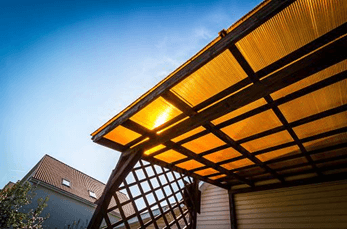Polycarbonate is a thermoplastic with a reputation for being exceptionally strong and resilient. With an impact strength that is 250 times stronger than glass and 30 times stronger than acrylic, polycarbonate panels have enjoyed increased use over the past few decades. Today, polycarbonate can be found being used for anything ranging from eye protection to bullet resistant glass!
Interestingly, a significant aspect of polycarbonate’s growth has been due to their utility as roofing panels. In fact, polycarbonate roof panels are one of the fastest-growing segments of commercial roofing products, especially for flat or low-slope roofs. This is because polycarbonate roof panels are less expensive than metal alternatives, and more durable than traditional asphalt shingles.
The few downsides of polycarbonate are typically insignificant for roofing purposes. Polycarbonate’s overall structural integrity will stay consistent, even after prolonged outdoor exposure. With few downsides and many benefits, let’s explore three key advantages of using polycarbonate roof panels.

Polycarbonate Roofing Panels Are Lightweight
Polycarbonate is one of the most lightweight roofing materials available. It weighs far less than a metal roof and is twice as lightweight as a glass panel of the same size. The lightweight qualities of polycarbonate roof panels introduce many considerable benefits. One immediate benefit is more reasonable shipping costs, especially when compared to metals. In addition to this, once construction begins, workers will likely appreciate how the polycarbonate is exceptionally easy to handle and install since it can be moved with little effort.
When designing a building, keep in mind that polycarbonate will likely improve its overall structural integrity. Since polycarbonate has an astonishingly low weight, less stress will be put on the walls and support beams of a building. While this benefit can be leveraged for many buildings, a prominent example would be a greenhouse. Although polycarbonate can be used for a greenhouse’s walls, they are typically constructed out of glass. By using polycarbonate roof panels instead of glass panels, the glass walls of the greenhouse will be under less stress – allowing them to enjoy a longer life.
[wbcr_snippet id=”534″]
Polycarbonate Roofing Panels Are Durable
Polycarbonate roofing panels can withstand an impressive amount of stress. Polycarbonate can sustain both boiling and freezing temperatures without losing any toughness, allowing it to thrive in outdoor conditions. The panels can also sustain most of the consequences of harsh weather – it repels water, can sustain the weight of snow, and won’t easily shatter due to hail or falling branches.
The high impact resistance of polycarbonate ultimately makes it more reliable than many other roofing materials. It’s unlikely to break during transport or installation, which will not only help ensure that the building is constructed according to schedule, it will also protect construction workers and result in fewer injuries. Once the building is finished being constructed, polycarbonate roofing panels will also provide exceptional safety to the people inside, especially when compared to materials like glass which shatter in a dangerous, dramatic fashion. This is part of the reason why polycarbonate panels are becoming more commonly utilized as skylights!
Polycarbonate is also exceptionally receptive to UV resistant coatings, meaning that constant sun exposure won’t cause the material to discolor, crack, chalk, or otherwise become weaker. This contributes to polycarbonate roof panels being exceptionally long-lasting. Although polycarbonate has only been used as a roofing material for about twenty years, many of the original buildings that used polycarbonate roofing are still enjoying its durability today.
Polycarbonate Roofing Panels Are Versatile
One of the greatest benefits of polycarbonate is its versatility. Polycarbonate roof panels are rigid enough to be completely solid and sustain plenty of weight without bending while being flexible enough to endure extremely powerful impacts without any serious breakage.
Polycarbonate roofing panels can also take on many aesthetic appearances. Opaque polycarbonate panels are available in a range of colors, although many designers choose to purchase grey or black panels. Polycarbonate panels can also be transparent – providing more light transmission than fiberglass while being almost as clear as glass. This makes polycarbonate a suitable replacement for glass when there are concerns about the safety or reliability of glass paneling. In addition to a range of colors and transparencies, these panels can be manufactured into a variety of sizes, thicknesses, and can even be formed into custom shapes.
Key Takeaways
Polycarbonate roof panels are becoming increasingly popular for many reasons. Due to polycarbonate’s versatility, durability, and low weight, designers and builders alike can appreciate its utility over similar materials like metal or asphalt. When designing structures such as commercial buildings, greenhouses, observatories, or even gazebos, don’t forget to consider how polycarbonate panels can function as a long-lasting, cost-effective roofing material.
Interested in using polycarbonate panels for your next building project? Take a look at our offering page for twinwall and multiwall polycarbonate sheets, perfect for roofing, skylights, and cladding. Or, if you have additional questions, contact us today.

